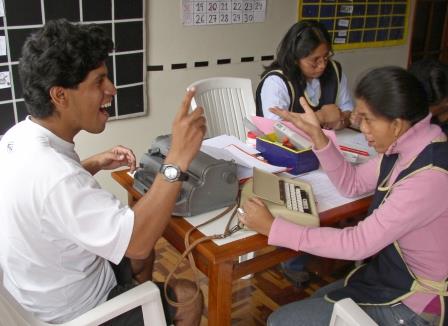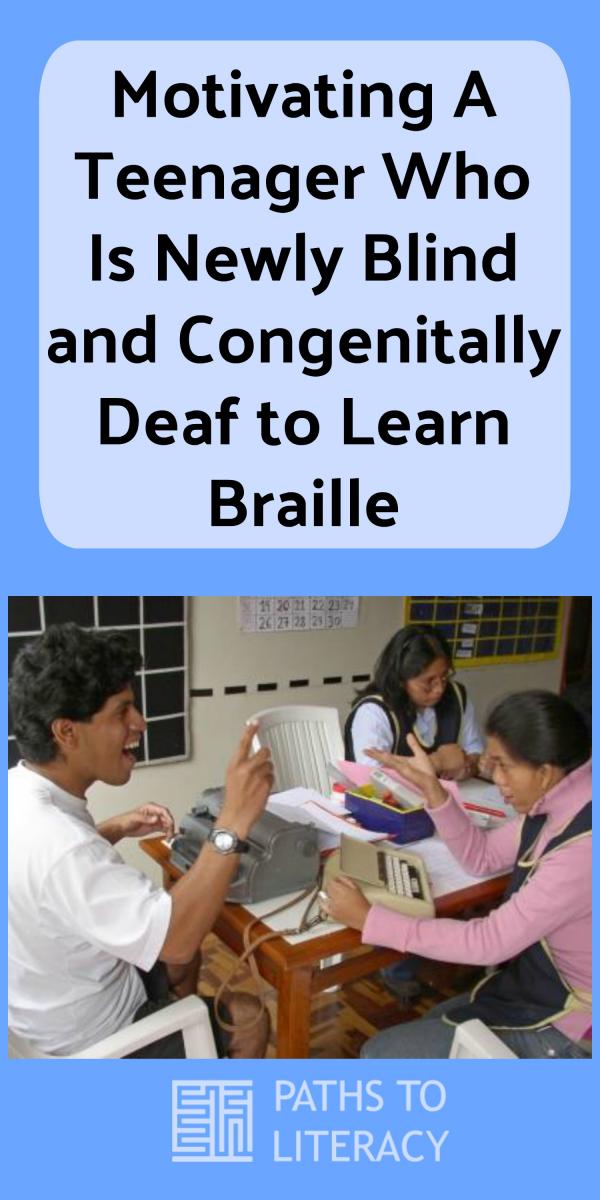Motivating A Teenager Who Is Newly Blind and Congenitally Deaf to Learn Braille
 The real purpose of this activity is to create motivation about braille for teenagers who are newly blind and congenitally deaf. This approach uses language experience stories written in contracted braille to give the full sense of braille. Once that motivation has been achieved, then you still need to do standard exercises to work on tactile letter discrimination, starting with uncontracted braille and then introducing sets of contractions as the student progresses. This method can be modified according to the student's level of accomplishment with literacy before blindness and level of motivation to read.
The real purpose of this activity is to create motivation about braille for teenagers who are newly blind and congenitally deaf. This approach uses language experience stories written in contracted braille to give the full sense of braille. Once that motivation has been achieved, then you still need to do standard exercises to work on tactile letter discrimination, starting with uncontracted braille and then introducing sets of contractions as the student progresses. This method can be modified according to the student's level of accomplishment with literacy before blindness and level of motivation to read.
I came to deaf-blind education from a special education background, and found that some of the things that I needed to know in order to teach effectively weren’t readily available,or just weren’t written down. Either you have to try to gather information yourself through trying to find and talk to experienced people, or just experiment. For example, there is a real lack of information on teaching braille to a person who is adventitiously blind and congenitally deaf, or, in other words, to someone who comes from an educational program geared to deafness and then becomes blind at age 10, 12, 14 years of age and needs to learn braille.
If you look at the standard methods of teaching braille to a young student who is blind and hearing, you’ll find that they’re based on a very phonetic approach geared for a child with whom you can talk through what they are learning, with whom you can talk and tactually track braille simultaneously. The students we are working with are going to have to use their hands simultaneously to sign and to receive signing as they’re learning braille, as they’re reading. This requires you to have to think of different ways of teaching it. You’re going to need to either sign or braille, moving back and forth between the two. Also, especially with children who are deaf-blind because of rubella, but also with some of our other kids who are deaf who have become adventitiously blind, if you look back, there are probably a lot of learning disabilities present and often their grasp of English structures is poor. Many have additionally had a visual problem long before they actually became blind, adding an additional limitation into the English learning process. You’ll tend to find, looking through reports, that they’ve had problems with reading all along because of these several factors: the difficulties in learning to read English imposed by deafness in the first place, complicated by the frequency of learning disabilities and the additional interference of faulty vision impeding communication reception in general.
Begin the Contracted Brailling of Student-Dictated Personal "Stories" Brailled by the Teacher.
I have found that, initially, the language experience method works-- having them dictate stories to you about something that happened to them, something that they’re interested in, or something that they heard about while you braille it out. Don’t begin with uncontracted braille where you’re brailling each single letter; rather, use contracted which is the level of material at which they will be reading, using all the contractions, and all the whole word signs. Ask the student to read it over with you. Braille a line that the student says to you and then ask the student read it along with you. At the beginning, although the student can’t actually “read” it, he’ll remember what he said, know that you brailled what he said, and will begin to develop a kind of whole word symbolism approach to reading.
Angry Feelings about Being Blind Can Interfere with Braille Learning.
This brailling period is intended to be a fun, interaction time when you’re trying to develop a good feeling toward learning braille. Braille learning is frustrating and tiresome for a person who is newly blind. It can be a negative experience since the student will probably also be dealing with all those feelings about “why am I blind?”, “how will I cope?”, with quite possibly still a lot of anger toward it and hence toward the need to learn braille which brings up the reality of the situation. You want to move them away from that. You want to try to develop some positive feeling about what they’re doing with the braille. So, at a separate time, do more analytic lessons on the alphabet, on contractions in isolation, using fingerspelling. If you begin at first only with analytic exercises, you’re likely to lose the student’s participation. They’re going to become so frustrated that they’re likely to hate braille, and reject it. The result will be a tremendous loss of time. But if you can immediately get them into the whole word contractions and just reading braille based on their own interests and ideas, then I think you can move it along a lot faster.
The Intrinsic Motivation of Wanting to Tell Something Important and to "Write It Down" Is More Motivating Than Extrinsic Rewards for Effort in Learning.
My approach is based on the really simple kind of idea that I think has gotten lost in working with students who are actually deaf-blind: that is, that they are tactual learners. This is so simple, but we forget it. They’re deaf; they’re blind; so of course they’re tactual learners and they learn through the tactual mode; so that you’ve got to have something “hands on” with everything you do. Secondly, they are still young, still growing, and very concerned with themselves. You’ve got to teach them, whether it be language in general or braille in particular from within. There has to be something which motivates their full participation in the learning event--it has to be full participation in the learning event-- it has to be a feeling inside. In the early years of education they often don’t deal with abstracted information at all because they have to reference to it, no frame of reference for using it.

Note: This article was originally published in Deaf-Blind education: Developing individually appropriate communication and language environments, Nan Robbins (Editor). Watertown, MA: Perkins School for the Blind, 1983. This post includes revisions by the author.
